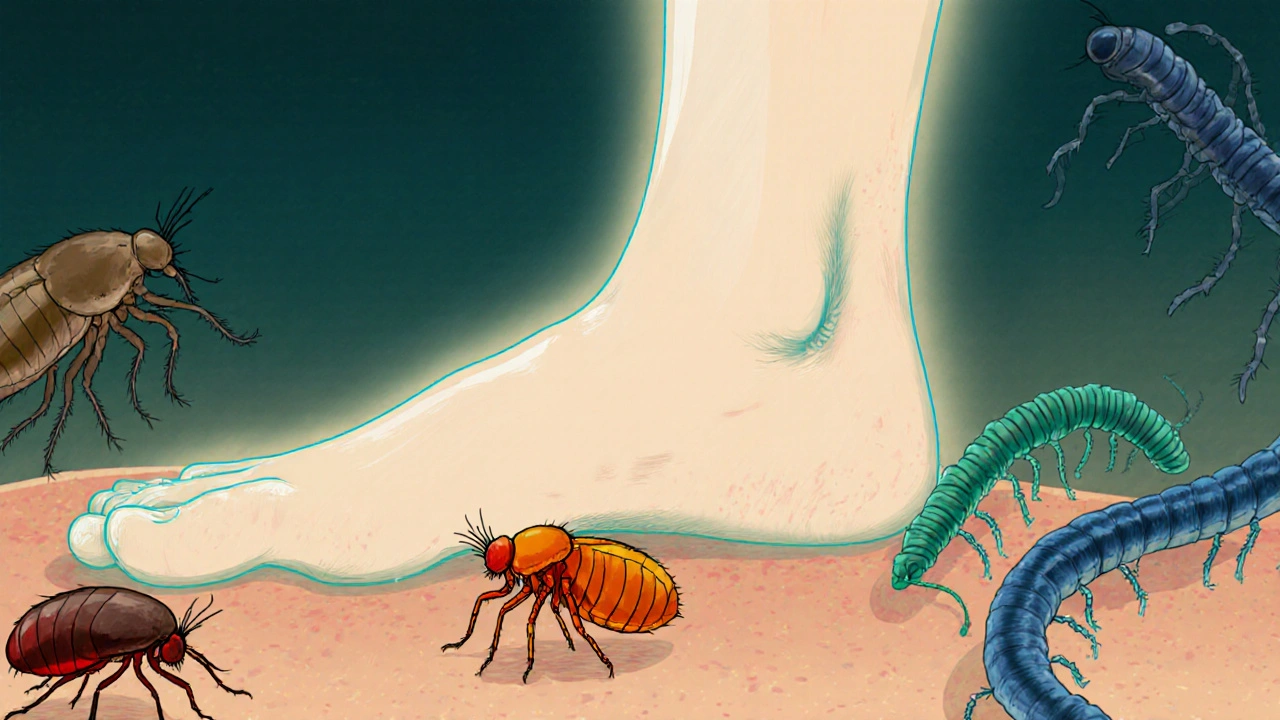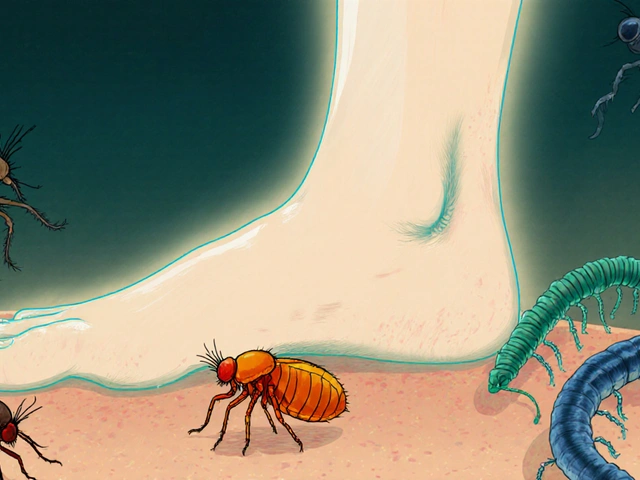Skin Parasite Prevalence Estimator
Estimate Infection Rates
Scabies (Sarcoptes scabiei)
Jigger Flea (Tunga penetrans)
Threadworm (Strongyloides stercoralis)
Skin‑invading parasites are organisms that live in, migrate through, or lay eggs in human skin. They cause a range of irritating, painful, and sometimes deadly conditions. With travel, climate change, and urbanization reshaping disease patterns, knowing where these parasites show up and how common they are has become essential for clinicians, travelers, and anyone curious about skin health.
Quick Takeaways
- Over 1.5 billion people worldwide are affected by at least one skin‑invading parasite each year.
- Hot, humid regions host the highest diversity of species, but globalization spreads them to temperate zones.
- Egg deposition patterns differ: some lay on the skin surface, others embed eggs deep within tissue.
- Effective control hinges on accurate diagnosis, hygiene, and targeted public‑health campaigns.
- Monitoring by the World Health Organization (WHO) and local health ministries guides prevention strategies.
What Counts as a Skin‑Invading Parasite?
Broadly, any helminth, arthropod, or protozoan that spends part of its life cycle inside human skin qualifies. This includes:
- Sarcoptes scabiei - the mite that causes scabies, burrowing just beneath the epidermis.
- Tunga penetrans - the jigger flea that embeds its abdomen into the skin to lay eggs.
- Strongyloides stercoralis - a threadworm whose larvae can penetrate intact skin.
- Hookworms (Ancylostoma duodenale, Necator americanus) - their infective larvae crawl through the skin of bare feet.
- Filarial worms such as Onchocerca volvulus and Loa loa - adult worms reside in sub‑cutaneous tissue, releasing microfilariae.
These organisms differ in size, lifecycle, and the way they deposit eggs or larvae, which directly influences prevalence patterns.
How Researchers Measure Global Prevalence
Prevalence estimates stem from a mix of population‑based surveys, hospital records, and WHO disease‑reporting systems. The most reliable figures come from:
- National health‑demographic surveys that include skin examinations.
- Sentinel surveillance in endemic hotspots (e.g., mining camps for cutaneous leishmaniasis).
- Published meta‑analyses that aggregate regional studies.
Data are usually expressed as a percentage of the total population or as cases per 1,000 inhabitants. Because many infections are asymptomatic, especially in early stages, true numbers are likely higher than reported.

Regional Hotspots and Their Signature Parasites
Below is a snapshot of the most common skin‑invading parasites by continent, together with their typical skin manifestations.
| Parasite | Geographic Distribution | Typical Skin Manifestation | Egg‑Laying Strategy | Estimated Global Prevalence |
|---|---|---|---|---|
| Sarcoptes scabiei | Worldwide, especially crowded urban slums | Intense itching, burrow tracks (20‑100 µm) | Live female lays 10‑20 eggs in a short tunnel under the epidermis | ~200 million (2.5 % of world population) |
| Tunga penetrans | Tropical Africa, Caribbean, South America | Inflamed, painful nodules on feet and hands | Female enlarges, produces >1,000 eggs that exit through a tiny vent | ~50 million (0.6 %) |
| Strongyloides stercoralis | Sub‑Saharan Africa, SE Asia, South America | Rash at entry site, sometimes larva currens (fast‑moving line) | Larvae hatch in gut, penetrate skin; no external egg stage | ~370 million (5 %) |
These three parasites together account for roughly 7‑8 % of the global population, making them the primary drivers of skin‑related parasitic disease burden.
Why Eggs Matter: Transmission and Public‑Health Implications
Eggs are the most resilient stage for many parasites. Understanding where they end up helps shape control measures:
- Surface‑laying eggs (e.g., scabies) can survive on clothing and bedding for days, driving person‑to‑person spread.
- Embedded eggs (e.g., jigger flea) hatch beneath the skin, causing secondary bacterial infections.
- Free‑living larvae (e.g., hookworm) move through soil, making footwear a simple but effective barrier.
Interventions therefore range from improved hygiene and laundering practices to mass drug administration (MDA) in endemic areas.
Case Studies: From Rural Villages to Urban Centers
Case 1 - Scabies in refugee camps: A 2023 WHO rapid assessment in a Syrian refugee camp reported a scabies prevalence of 28 %. Overcrowding, limited washing facilities, and delayed diagnosis fueled the outbreak. After a single dose of ivermectin given to all residents, prevalence dropped to 7 % in three months.
Case 2 - Jigger flea in the Caribbean: In rural Haiti, children playing barefoot on sandy beaches contract tungiasis at rates as high as 15 % during the rainy season. Community‑led shoe‑distribution programs and weekly foot‑scrubbing with soap reduced new cases by 60 % within a year.
Case 3 - Strongyloidiasis in Southeast Asia: In a Thai rice‑farming community, routine stool checks uncovered a hidden Strongyloides prevalence of 9 %. Because the parasite can auto‑infect and persist for decades, health officials introduced a yearly albendazole‑ivermectin combo, cutting infection rates to below 1 % after five cycles.

Prevention Tips You Can Use Today
Even if you’re not traveling to endemic zones, simple habits lower risk:
- Wear closed shoes on soil or sand, especially in tropical regions.
- Wash clothes and bedding regularly at ≥60 °C; heat kills scabies eggs.
- Avoid walking barefoot in areas where animal feces are visible.
- Seek prompt medical evaluation for persistent rashes or itching.
- If you work with livestock, use gloves and wash hands thoroughly after handling animals.
These steps are low‑cost, high‑impact, and easy to adopt in both developed and developing settings.
Future Outlook: Climate Change and Migration
Warming temperatures expand the habitable range for many arthropods and soil‑borne larvae. Modeling by the International Centre for Genetic Engineering and Biotechnology (ICGEB) predicts a 20 % northward shift of hookworm‑suitable zones by 2050. Likewise, increased human migration from conflict zones may spread scabies to previously low‑prevalence countries.
Public‑health agencies are therefore integrating skin‑parasite surveillance into broader climate‑adaptation plans, leveraging mobile health (mHealth) apps for real‑time reporting.
Key Takeaway: A Global Challenge Requiring Local Action
The numbers are striking: over skin parasites affect billions, and their eggs keep the cycle turning. Yet the good news is that most infections are preventable and treatable with existing tools. By staying informed, practicing good hygiene, and supporting community‑level programs, we can push prevalence down and keep skin health on the global agenda.
What are the most common skin‑invading parasites worldwide?
The three most widespread are Sarcoptes scabiei (scabies mite), Tunga penetrans (jigger flea), and Strongyloides stercoralis (threadworm). Together they affect roughly 7‑8 % of the global population.
How is prevalence measured for these parasites?
Researchers combine national health surveys, sentinel site data, and WHO reporting. Results are expressed as a percentage of the total population or cases per 1,000 people, with adjustments for under‑reporting.
Can I contract these parasites from pets?
Some, like the jigger flea, originate from animal reservoirs and can jump to humans. Maintaining regular veterinary care and keeping pets clean reduces the risk.
What treatments are available?
Topical permethrin and oral ivermectin are first‑line for scabies. Albendazole or ivermectin treats Strongyloides. For tungiasis, surgical extraction of the flea plus antibiotics for secondary infection is standard.
How does climate change affect skin parasite spread?
Warmer, wetter climates expand habitats for soil‑borne larvae and arthropods, moving endemic zones into higher latitudes. This raises exposure risk for populations previously considered low‑risk.






Reviews
When I heard my neighbor’s kid was scratching nonstop, I thought it was just a simple allergy, but the doctor said it was scabies. The way those mites burrow under the skin is oddly fascinating, if you enjoy microscopic horror stories. It’s also a reminder that crowded living conditions can turn a tiny creature into a public‑health nightmare. A quick wash‑and‑dry cycle at high temperature can actually kill the eggs, so laundry isn’t just about smelling good. I wish more people realized that simple hygiene steps can stop a parasite outbreak before it spreads. The irony is that the same habits that keep us comfortable also keep the parasites at bay.
Wow, thanks for the reminder – I never knew my laundry could be a superhero 🦸♀️. It’s crazy how a few minutes of hot water can make the difference between itchy misery and smooth skin. Keep spreading the word, because if we all toss our socks in 60°C, the mites will have no vacation spot. 😉 Also, kudos for keeping it simple and not turning it into a science lecture.
Let me set the record straight about these so‑called “global skin parasites” before any misguided patriot tries to downplay their significance. First, the sheer numbers – over a billion individuals are affected annually – is not a trivial statistic that can be brushed aside as a buzzword. Second, the distribution maps clearly show that these organisms respect no political borders; they migrate with humans, animals, and even cargo ships, rendering any nationalist denial utterly useless. Third, the life cycles of Sarcoptes scabiei, Tunga penetrans, and Strongyloides stercoralis have been meticulously documented in peer‑reviewed journals, and the data consistently corroborate the prevalence figures cited in reputable health agencies. Fourth, the economic burden of untreated infestations includes lost productivity, increased healthcare costs, and secondary bacterial infections, which collectively strain national economies. Fifth, climate change is expanding the habitats of soil‑borne larvae, meaning that even temperate regions are witnessing a rise in hookworm cases, a fact that should alarm any policy‑maker concerned with public health. Sixth, the WHO’s own surveillance programs have identified hotspots that align with our own epidemiological models, confirming the validity of the data. Seventh, ignoring these trends in favor of isolationist rhetoric not only jeopardizes domestic health but also undermines international cooperation that is essential for disease control. Eighth, mass drug administration programs in endemic areas have demonstrated measurable reductions in prevalence, a success story that should be emulated worldwide. Ninth, the simple act of wearing shoes on bare soil can prevent countless infections, yet many citizens are unaware of this low‑cost measure. Tenth, education campaigns that emphasize proper laundry temperatures have proven effective in curbing scabies outbreaks in refugee camps, a testament to the power of basic hygiene. Eleventh, the diagnostic challenges posed by asymptomatic carriers underscore the need for robust surveillance rather than complacent denial. Twelfth, the genetic studies on these parasites reveal adaptations that enable them to thrive in diverse environments, further disproving any notion that they are confined to “exotic” locales. Thirteenth, we must recognize that the fight against skin parasites is a global effort, requiring coordinated research, funding, and political will. Fourteenth, the moral imperative to protect vulnerable populations from preventable suffering should transcend any misguided sense of national superiority.
Sure, because a hot wash is the ultimate weapon against a microscopic nightmare. It’s almost poetic how something as simple as temperature can outsmart a creature that’s been around since the dawn of humanity. Guess we’ve been overcomplicating health for far too long.
People forget that a pair of shoes can stop a lot of these parasites.
i think the world is like a big skin canvas, where tiny critters paint their story and we just ignore the mess. later u realize ur toes are the map of history, each bite a reminder that nature doesnt care about our comfort. its like a dance of fate and infection, a loop that shows us how interwoven our lives are with the unseen. if we stop walking barefoot we maybe stop some chapters of that grim story. just a thought, not a lecture.
Honestly, the world is being invaded by these tiny monsters and most of us act like it's nothing! The drama of crawling larvae, the agony of itching, and the silence of governments pretending it's not a problem-it's all so *cliché* but true. We need to wake up, clean our homes, and demand proper treatments instead of hoping they disappear on their own. If we keep ignoring the signs, the parasites will keep thriving, and we will be the ones left scratching. Simple steps like washing clothes at 60°C can save millions, yet nobody seems to care enough to shout about it! This is the reality we must face, not some polite excuse.
The data unequivocally support that hot laundry kills scabies eggs; any claim otherwise is misinformation.
i hear all this and wonder why big pharma never pushes a free 60°C wash cycle for everyone. maybe they profit from the endless itch and the meds they sell. the truth is hidden behind a veil of “science” and we just get told to buy creams. stay woke, folks.